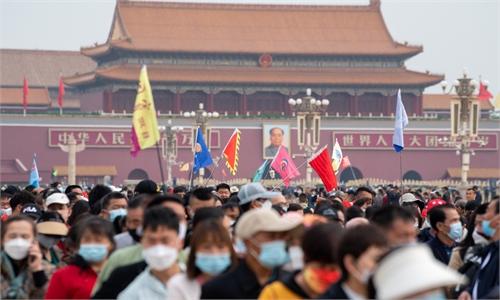Travel surge continues for May Day holidays as millions of tourists prepare to head home

Tourists enjoy rafting in Wuzhishan City, south China's Hainan Province, April 30, 2023. China is witnessing a travel boom during this year's five-day May Day holiday. (Photo by Guo Zhihua/Xinhua)
China's travel spree continues as the May Day holidays, the second post-pandemic holiday after the Spring Festival, entered its second half, creating online buzz and boosting expectations for the nation's economic recovery.
With multiple tourist venues across China reporting tickets being sold out and tourists sites overwhelmed by swarms of tourists, several internet memes quickly went viral across the Web.
At the Yueyaquan scenic area in Dunhuang, Northwest China's Gansu Province, scenic site operators erected traffic lights to guide long lines of tourist-carrying camels to avoid a congestion of traffic on the "silk road" and the move that drew a host of humorous online comparisons.
Such memes were not unique as netizens joked that they have not only seen mountains and seas during this year's May Day holidays but also "people mountains and people seas", using word play based on a famous Chinese idiom.
The West Lake scenic spot in Hangzhou, East China's Zhejiang Province ranked No.1 among highly rated outdoor scenic areas that received the most tourists across China from Saturday to Monday afternoon, according to a CGTN report, citing analysis.
Other top ranking scenic areas including the Fuzimiao (Confucius Temple)-Qinhuai Scenic Area in Nanjing, East China's Jiangsu Province, the Summer Palace in Beijing and the ancient town of Dali, in Southwest China's Yunnan Province.
In Yanji, a city in Northeast Chinas' Jilin Province that sits on the border with North Korea with a population of roughly 700,000, an estimated 20,000 to 30,000 tourists are "pouring into the city on a daily basis," according to the observation of a Beijing-based tourist surnamed Wang.
"The city seems to have run all of its means to receive so many tourists all at once," said Wang, who traveled to the Yanji with is family during the break. "We booked a table at an internet-celebrity restaurant earlier in the morning, and were only able to eat our meal by evening. It was that crowded."
For people who chose to stay at home, dining out and shopping or even lodging at suburban guesthouses become a must.
Data from Beijing's commerce authorities showed that during the first three days of the holidays, some 22.72 million people visited the capital's 60 key commercial areas, up 79.2 percent year-on-year. UnionPay data showed spending on goods increased by 41.7 percent while money spent on services soared by 32.3 percent from corresponding levels last year in the city.
Hong Kong and Macao, the two Special Administrative Regions, also witnessed a surge in tourists from the mainland.
Hong Kong's Chief Executive John Lee said on Tuesday that he expected a total of 600,000 mainland tourists would visit Hong Kong. Over the weekend, more than 760,000 people entered Hong Kong, of which 320,000 were from the mainland, Lee said.
Lee said along with the economic growth in the mainland, and the accelerated recovery in the local civil aviation sector, Hong Kong's economy in the second quarter is expected to grow further, according to a report by hket.com. In the first quarter, Hong Kong's economy grew by 2.7 percent year-on-year, Lee said.
In Macao, more than 100,000 visitors arrived each day on Saturday and Sunday, local media reported, citing government statistics, up from 60,000 only a few days earlier.
Experts said the tourism boom during the May Day holidays is reflective to the accelerated pace of recovery in consumption seen in the first quarter, as the central government has placed more emphasis on tapping the potential of the consumption sector in the post-epidemic period.
Li Changan, a professor at the Academy of China Open Economy Studies of the University of International Business and Economics, told the Global Times on Tuesday that much of the data, with the exception for the outbound tourism sector, indicated consumption during this year's May Day holidays have exceeded that of the 2019.
Banking on the positive momentum during the May Day holidays, social retail growth in May is on track to outpace fast-recovering rate previous months, Li said. In March, China's social retail grew by 10.6 percent year-on-year as the economy stages a recovery from the epidemic.
Retail consumption has already regained its status as China's biggest growth engine during the first quarter, when it accounted for 66.6 percent of GDP, up from 2022's 55 percent.
Moreover, the golden week also witnessed a surge in the number of moviegoers in what the Economic Daily described as a strong recovery of the overall film market.
As people flock to cinemas during the holidays, China's box office has reached 1 billion yuan ($145 million) as of 6 pm Monday, Chinese ticketing platform Maoyan showed.
The average movie ticket was sold at 42.2 yuan per ticket on May 1, a 23.39 percent rise from that of 2022, data showed.
A total of 19 new movies hit the silver screen during the holiday, which is a historical high, according to the Economic Daily report.
In 2019, May Day holidays box office once reached 1.5 billion yuan.
As this year's May Day holidays, which runs from April 29 to May 3, enters its second half, people have begun to prepare for the journey home.
China's state railway operator expects a total of 16.45 million passenger trips to be made on Tuesday, slightly down from the 16.826 million passenger trips seen on Monday. Planned train services are 11,548, slightly higher than Monday's 10,944. Wednesday will see the peak in returning trips made by tourists who have ventured outside their home cities, the railway operator said.
A total of 3.6 million passengers are expected to hit the road on railways in the Yangtze River Delta region on Tuesday, after Monday's passenger volume saw a surge of 31.6 percent compared with 2019 level with 3.711 million trips made, the local railway operator said.
From April 27 to May 4, the railway operator expected 120 million trips to be made, up 20 percent from 2019 levels - before the epidemic hit, representing a further record setting high.




